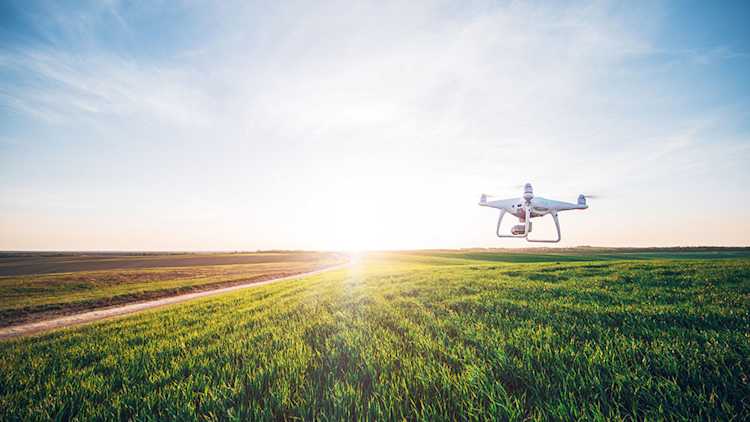Let’s review big tech – how’s it going?

Drones, robotics, and artificial intelligence received a lot of attention as potential game changers a few years ago. A quick review shows slow but steady progress and, in some cases, provides a reality check.
I remember reading an article a few years ago that predicted a cropping system whereby connected soil and crop canopy sensors would monitor field conditions in real time. When sensors detected conditions conducive to a specific disease or pest, it would trigger an autonomous aerial drone sprayer that would load the appropriate products and spot spray areas with the highest disease or pest pressure. No human effort or interaction required. Mind blown.
With a few years of experience, it’s a good time to look at how these technologies have evolved and what their impact has been.
Drones and diagnostics
Drones were a hot item a few years ago and because they were becoming much more affordable, they gained a lot of traction with farmers and crop consultants. The pitch was that drones could fly over every inch of every field and, using various cameras and sensors, generate huge data files that would be fed into an advanced agronomic algorithm to spit out management instructions and solutions.
Aaron Breimer is vice-president of data insights with Deveron Corp. based in Chatham, Ont. “The potential is still there for advanced diagnostics using aerial drones. There is a lot of work underway on developing the algorithms and we’ve had success predicting and treating white mold in soybeans and white beans. We’re also finding solid value in using drones to monitor and assess research plots where we can fly low, use high resolution cameras and do detailed analysis,” Breimer says.
The more common use for drones is simple scouting. “The price of drones came down to the point where a farmer or scout could buy a reasonable drone for $3,000 or less. It allowed for a quick look at a field that might take hours to walk but a drone could scan quickly in 20 minutes. Cameras can take a picture of areas in the field that look unusual. Scouts can then ground-proof those spots and save time not having to walk every acre.”
A lot of relatively inexpensive drones were purchased but failed to find regular use or deliver value. Jim Hale is a Lancer, Sask., pulse, oilseed and cereal producer who watches emerging ag tech closely. Hale bought a drone a few winters ago. “I crashed it, lost it, found it the following spring and now it’s sitting on a shelf. It worked OK but I wasn’t compelled to look into which camera and software I should use, and the Transport Canada regulations seemed kind of complicated.” The arrival of low-cost or free satellite services that generate plant health imagery allowed many growers to skip the drone.
Robotics finding a foothold
Robotic technology is advancing quickly with numerous companies introducing prototypes that show great promise. For example, a robot that picks up bales and stacks them in a designated location, or soil sampling robots that can use GPS directions. “We are at discovery stage where manufacturers and farmers are looking to find a fit. Robotics will take hold to address pain points,” Breimer says. “And this may cover a wide range of tasks. If a farm is struggling to find people to fill jobs, there will be a strong motivation to utilize robotics, especially for unpleasant repetitive tasks.”
From an agronomic perspective, Breimer sees great potential for small robotic field units to eventually replace heavy high-horsepower tractors. “It’s going to take time, but I see soil compaction as one of our biggest challenges and the swarm farming concept could address the yield losses we see due to compaction.”
For Hale, the autonomous machine from Raven Industries called OmniPower is of great interest because it completely re-imagined what a tractor could look like. “I like the disruptive thinking, but there are a lot of challenges to make autonomous equipment like OmniPower fit for different types and sizes of operation. I’m more interested in finding ways to upgrade my current equipment. A kit that would convert my existing grain cart tractor to autonomous operation is more realistic than looking at swarm farming.”
Is AI reliable?
One technology Hale is interested in relies on artificial intelligence. “Sprayer technology that detects weeds and turns on and off to only spray when weeds are present has been around for a while, but now it can detect weeds from crop,” Hale says. This advance is the result of using a lot of data to create an algorithm that accurately tells the sprayer when to turn on and off – a textbook definition of artificial intelligence.
Artificial intelligence applications across agriculture will only get better as more and more data and iterations are processed.
Hale is also interested in doing more variable rate seeding and fertility management, but it’s still a work in progress. “The agronomy-based algorithms are hard to trust. My sense is that they are reliable under normal growing conditions, but don’t always adapt well to extremes and 2021 was an extreme year for us.” While remaining a bit skeptical, Hale acknowledges that artificial intelligence applications across agriculture will only get better as more and more data and iterations are processed. That’s how progress is made.
When asked to predict what technologies they see gathering momentum in the coming years, both Breimer and Hale suggest that all the innovations we’ve talked about will be put to better use to apply, monitor and manage crop fertility.
From an AgriSuccess article by Peter Gredig.
